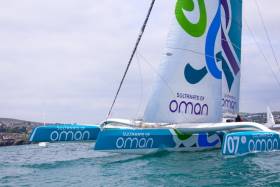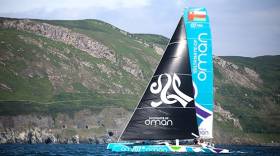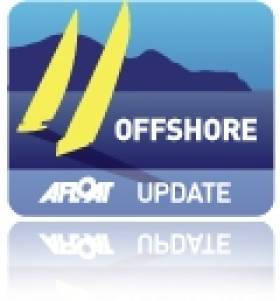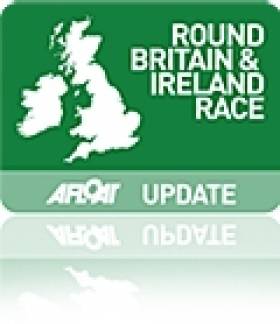Displaying items by tag: MusandamOman Sail
Crew Safely Ashore But How Did Musandam-Oman Sail Capsize?
The Musandam-Oman Sail crew were safely transferred ashore in Newfoundland overnight following the capsize of the MOD70 trimaran on Sunday morning while racing the Transat Quebec-St Malo but there is still no explanation of why the 70–foot Round Ireland speed record holder capsized.
The team has been medically assessed and they are well. Ireland’s Damian Foxall and Mayeul Riffet from France are supporting Loik Gallon and the shore team with recovering the MOD70 while the other team members, French skipper Sidney Gavignet, Fahad Al Hasni (OMA) and Alex Pella (ESP) will return home to their families.
“We are thankful and hugely relieved that the crew are safe and sound and on dry land,” said David Graham, Oman Sail CEO.
“We have a great team and they are now fully focussed on recovering Musandam-Oman Sail.
“We would like to take this opportunity to thank the Joint Rescue Coordination Centre Halifax, the cargo ship Torm Alexandra that rescued the crew and the Transat Quebec-St Malo race management for their support with this operation.
“Thank you also to all our supporters around the world who have sent messages and well wishes to the crew and the team – we are very grateful for your support.”
The capsize happened in the early hours on Sunday 17 July approximately 450 nautical miles east of St Pierre and Miquelon.
Following the capsize of Musandam-Oman Sail early Sunday morning, the five sailors have been safely transferred to a cargo ship and are in transit back to Canada.
The capsize happened in the early hours of Sunday approximately 450 nautical miles east of St Pierre and Miquelon while racing the Transat Quebec-St Malo.
The team is currently assessing solutions for recovering the MOD70.
The Round Ireland Speed Record champion, the MOD 70 trimaran Oman sail continues to search for a missing crew member lost overboard.
Mohammed Al Alawi, 26-year-old crew member of MOD70 trimaran Musandam-Oman Sail remains missing this evening following a Man Overboard incident last Wednesday 7 October in the early hours of the morning, pre-dawn, just south of Pula in Croatia while the MOD70 was en route from France to Trieste in Italy for the Barcolana.
Musandam-Oman Sail - flagship of the Sultanate of Oman - successfully completed a Round Ireland speed sailing record attempt last May taking three hours off the 22–year–old record, breaking Steve Fossett's long standing record of 44 hours with Lakota in 1993. Her crew that did not include the missing sailor were based at the National Yacht Club in Dun Laoghaire.
Day four and the extensive search for Mohammed continues and the search area has extended into Italian waters; the search team has been a mix of Oman Sail, private search and rescue companies and the Croatian coastguard, using helicopters, airplanes, and boats including Musandam-Oman Sail. Today's inclement weather of strong easterly winds, limited visibility and rain was not conducive to a detailed search.
Ahmed Al Alawi, father of Mohammed, who is in Croatia with the team said "We [the family] extend our deep gratitude to all who are supporting this search, especially the Omani Government, the staff of Oman Sail, Her Excellency The Sultanate of Oman's Honorary Consul of Croatia and the Croatian Coastguard who have been exemplary. We have been inundated with heart-felt messages of support which are much appreciated." The search continues.
Search updates can be found here
#roundirelandspeeedsailing record – It's been a tricky second night at sea for Musandam-Oman Sail's in its Round Ireland speed sailing record bid. At 0600 the six-man international team is speeding past Dungarvan on the south coast at over 24 knots. It's an impressive speed but there is still approximately 120–nautical miles to sail to the Dublin Bay finish line. Force six winds are blowing from a favourable westerly direction and forecast to get stronger this morning and there is a flood tide until lunchtime, but several hours spent in little wind off the Mayo coast yesterday afternoon may yet prove costly.
This time yesterday, the crew were surfing across the top of Donegal. Only 12 hours ago, the team was halfway down the west coast of Ireland in a low pressure and 'on track for a mid–morning finish' this morning. Reports from onboard last night said 'It is likely to be a challenging night'. Since then they have sailed 170–nautical miles to the Fastnet Rock, hitting speeds of 27 knots off the Kerry coast. They came close inshore at Cape Clear at midnight before heading offshore again in an attempt to make faster progress along the Munster coast. Since midnight the crew have been focussing on the final 200 nautical miles to the finish.
To beat the 22–year record set by Steve Fosset's Lakota in 1993, the Oman Sail Mod 70 Multihull needs to cross the line before 1400 hours this afternoon. At 0800, with the final 100nm to go, the team, who had originally signalled an ETA at 'mid–morning' have revised this to be 'middle of the day'. It is an indication perhaps, if the Fosset record is broken, it will not be by much even if speeds do increase up the Wexford and Wicklow coasts this morning.
Kerry Yachtsman On Verge of New Round Britain & Ireland Record
At 1230 BST, Damian Foxall's Musandam-Oman Sail were 520 miles from the finish of the Sevenstar Round Britain and Ireland Race. To set a new outright World Record, the MOD 70 needs to cross the Royal Yacht Squadron Line by 12:59:14 tomorrow (14th August).
Musandam-Oman Sail has been on the charge all morning and last night averaged over 25 knots, hitting a top speed of 35 knots. At that pace the World Record would be broken by over 3 hours. Before the famous Trimaran left Cowes on Monday morning, Foxall told Afloat.ie a record breaking time was on the cards.
During the third night of the race, a northwesterly breeze of about 19 knots is expected in the Celtic Sea, which should be enough to keep Musandam-Oman Sail on for the record and make landfall at The Lizard around midnight tonight. During the night, the wind is expected to go lighter and back to the west, which could make for a dramatic last few hours as Musandam-Oman Sail round the Isle of Wight, before crossing the finish line from the east.
County Kerry's Damian Foxall called the RORC by satellite phone earlier today while racing at full pelt against the clock, past his native Ireland on the MOD 70.
"We are just 15 miles from Blackrock, in sunshine on the West Coast of Ireland. I can see Galway and Connemara to leeward," commented Damian. "The wind has just lined up beautifully and we haven't really needed to gybe, so we are just going straight, corner to corner, towards the next mark, Tearaght Island. We have the inkling of an idea that it might be possible, in a dream world, to beat Banque Populaire's record. We are pushing hard, towards near where I grew up; Bull Rock. With the wind going lighter and to the west, we will be dead down wind, which will mean a lot of gybes, but we will see how tomorrow goes; for now we are keeping alive the idea that we can break the course record."
Abu Dhabi Ocean Racing's Volvo Ocean 65, Azzam, continues to lead the charge and has extended their lead on Team Campos, skippered by Iker Martinez, to over 30 miles. Ian Walker's team has a bevy of outstanding drivers, whom Walker praised when he spoke to the RORC Media team by satellite phone.
"10 miles until we can bear away at St Kilda and the thrashing will subside," commented Ian. "It was a tough night with up to 36 knots of wind and sustained periods of 30+. We have continued to push the boat as hard as we can - only once backing off as it felt like we were going to shake everything to pieces. I think it is paying good dividends having so many capable helmsmen, as we are going well. It is pretty intense on the body and mind. Most of the helmsmen's hands are in tatters for a start!"
Brian Thompson, skipper of IMOCA 60 Artemis-Team Endeavour, contacted the RORC Media Team as they rounded Out Stack. At their current projected finish time, Artemis-Team Endeavour will break the IMOCA 60 record, set in 2010, by over 24 hours.
"We haven't gone upwind since the start and, as we arrived at Muckle Flugga, the breeze switched around 180 degrees and we still haven't!" explained Brian. "I have held the overall record three times, including onboard Banque Populaire, so to add the IMOCA record would be fantastic. It's looking hopeful; four years ago it took Artemis two and a half days to get up to the top of the course, so we are already 12 hours ahead of their track. Apart from some bad sea-state plugging the tide at Great Yarmouth, we have been up to full pace. Right now, we are just taking it a leg at a time but we think we will be in Cowes for a Sunday Roast."
The competitors' blogs tell the story of the race through the words and pictures sent back by the fleet and one of the more humorous stories is told by Jankees Lampe's whose Open 40, La Promesse, is leading IRC One and currently 150 miles from Muckle Flugga. Earlier today, the Dutch skipper blogged about the culinary delights on board and the special dietary demands of his fellow Two-Handed crew.
"Bart Boosman's famous omelette (breakfast, lunch, brunch, dinner, whenever)
1. onions 2. onions 3. Red Leicester (cheddar) 4. eggs 5. pepper & salt 6. onions
The cooking is acrobatics. But, both Bart and I, prefer shaken, not stirred."
































































